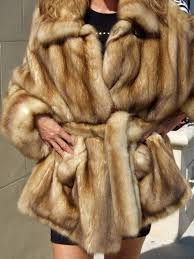COMING SOON HOUSE ADVERTISING ads_leader
The sable is a marten, prevalent throughout the region east of the Ural Mountains, into Siberia, Northern Mongolia, China, Korea, and even northern Japan (Hokkaido). It is valued for its fur throughout the years, but seen and worn less frequently than mink and chinchilla. The wild animals still exist in Siberia, but are now mostly commercially farmed for production. Will I see one in the wild? The live in dense forests in mostly mountainous terrain. But they can travel up to 7.5 miles in search of food. They live in burrow, not boroughs, near river banks, or in the thickest parts of the woods. They are known to be good climbers of cliffs and trees. Interestingly, they are omnivores, eating hares and other small mammals. In the winter, they can switch to berries, rodents, and even small musk deer. They can even eat mollusks and fish, especially on Fridays.
xYrstUeAKudnmja42vwTHzWywO8RBaXYcOik%!d(MISSING)0&url=http%!a(MISSING)%!f(MISSING)%!f(MISSING)upload.wikimedia.org%!f(MISSING)wikipedia%!f(MISSING)commons%!f(MISSING)thumb%!f(MISSING)f%!f(MISSING)f4%!f(MISSING)Sable_skins_Bargusinski.jpg%!f(MISSING)440px-Sable_skins_Bargusinski.jpg)
About the only place to see sable would be a big department store in New York or Chicago, maybe Paris or Munich as well. One of the regions I am visiting is Lake Baikal, famous for its sable population. The sable fur here is a deep jet black with white tipped hair. Each skin can fetch from $80-90 by the fur trader. But now sea otters on the Kamchatka peninsula are considered more valuable. The Russian fur industry only produces 25,000 skins per year, with most going to Germany and France.

I am just not sure about this. What do you think? I do not see this as a very useful animal.
COMING SOON HOUSE ADVERTISING ads_leader_blog_bottom
Tot: 0.429s; Tpl: 0.008s; cc: 36; qc: 153; dbt: 0.2895s; 1; m:domysql w:travelblog (10.17.0.13); sld: 1;
; mem: 1.4mb
xYrstUeAKudnmja42vwTHzWywO8RBaXYcOik%!d(MISSING)0&url=http%!a(MISSING)%!f(MISSING)%!f(MISSING)upload.wikimedia.org%!f(MISSING)wikipedia%!f(MISSING)commons%!f(MISSING)thumb%!f(MISSING)f%!f(MISSING)f4%!f(MISSING)Sable_skins_Bargusinski.jpg%!f(MISSING)440px-Sable_skins_Bargusinski.jpg) About the only place to see sable would be a big department store in New York or Chicago, maybe Paris or Munich as well. One of the regions I am visiting is Lake Baikal, famous for its sable population. The sable fur here is a deep jet black with white tipped hair. Each skin can fetch from $80-90 by the fur trader. But now sea otters on the Kamchatka peninsula are considered more valuable. The Russian fur industry only produces 25,000 skins per year, with most going to Germany and France.
About the only place to see sable would be a big department store in New York or Chicago, maybe Paris or Munich as well. One of the regions I am visiting is Lake Baikal, famous for its sable population. The sable fur here is a deep jet black with white tipped hair. Each skin can fetch from $80-90 by the fur trader. But now sea otters on the Kamchatka peninsula are considered more valuable. The Russian fur industry only produces 25,000 skins per year, with most going to Germany and France.